John Lubbock (*)
In the week leading up to the 100th anniversary of the Armenian Genocide, British-Armenian historian Ara Sarafian
led a group of students, academics and journalists on a mission to
engage with local Kurds and the descendants of Armenians in the Kurdish
region of Turkey.
It was in these towns and villages, 100 years ago, that the Armenian
population, as well as many Assyrians, were forced from their homes and
killed or deported by the state and its deputies. The Ottoman
bureaucracy, supposedly fearing non-Turkish populations would revolt and
carve off Ottoman lands to create new nation-states, exploited tribal,
class and ethnic tensions to encourage local Kurdish leaders to murder
their neighbours and steal their lands.
Sarafian has been travelling to this region, and especially the main
Eastern city of Diyarbakir, for years, engaging with locals and trying
to build bridges with the local community.
“Many Armenians were skeptical; saying ‘well, Diyarbakir is an exception’,” says Sarafian. “In a way, to test that. . . [I said] let’s try to build the bridges that were destroyed 100 years ago [in Bitlis] between Armenians and Kurds.” Based in London, with no real contacts in the region, Sarafian began making contacts through social media. When he arrived in the area he organised a meeting. “Many Kurdish organisations joined and right from the beginning the sentiment was the same: the Kurds acknowledge that there was a genocide that needs to be addressed and we should do everything to reverse its consequences as far as possible.”
Sarafian took us to the sites of former Armenian villages like Khanelmali (Khntsorkin
in Armenian) near Tatvan, where remnants of old churches stand, often
used by Kurdish villagers as stables for animals or barns for hay. In
the village of Degirmenalti (Por in Armenian and Kurdish), an old monastery includes some of the most impressive medieval Khachkar
stones in existence. These monumental carved stones were made by monks
to show their devotion and artistry. In the past five years some have
been knocked down to build houses, though there is hope that they may
survive beneath the foundations, waiting to be recovered.
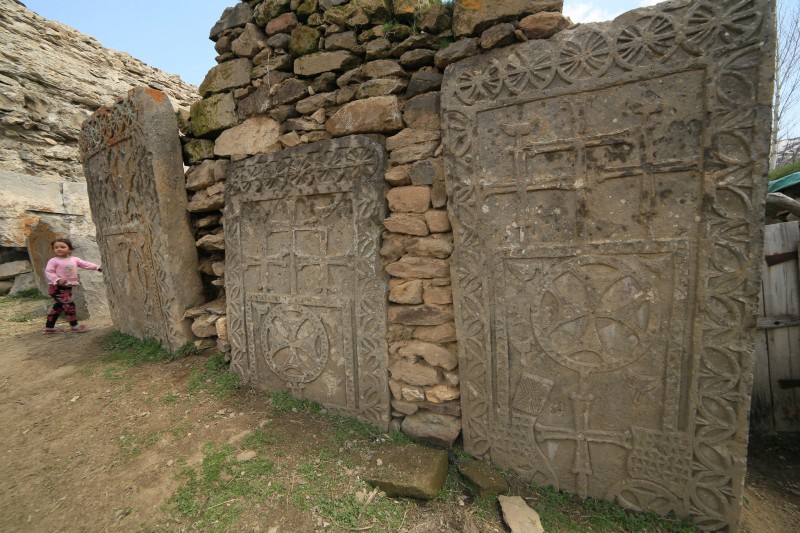
Khatchkar stones
In Bitlis we attended an event entitled “What Happened to Bitlis
Armenians, 1915-2015,” organised by Sarafian along with Kurdish and
Turkish lawyers and activists. It comprised a photographic exhibition on
Armenians in Bitlis, followed by presentations by speakers including
the Turkish sociologist and human rights’ activist, Ismail Beşikçi, who spent 19 years in Turkish jails for speaking out on the Kurdish issue.
“I saw church ruins, so many church ruins. Where is the community of
these churches? Asking this question is related to having social and
historical awareness. In 1962/1963 I didn’t have awareness or
information,” Beşikçi said.
Behvat Şerefhanoğlu, a local man and father of our guide Barzan, told
the audience the story of what his family witnessed in 1915.
“My uncle was one of the direct witnesses of the killings. There was a
stone bridge in Mutki. My uncle told me that 80% of the Armenians
living in that area were slaughtered by the bridge. Those Armenians were
begging, “O Muslim, for the sake of Muhammad, kill me with one bullet.”
Even though they begged, they kept shooting them in their knees. This
is a massacre. We are the children of two grieving nations.”
We drive into the hills near Mutki to visit what was once a huge
monastery on the highland slopes. From afar, St. Aghperig looks almost
intact, but up close it is covered with holes where treasure hunters
obsessed by rumours that Armenians buried gold in their places of
worship come to dig. St. Aghperig is beautiful even in its current
state, but badly needs protection. This will be difficult without
investment from outside, which will be hard to secure when the
government wants to retain all land rights.
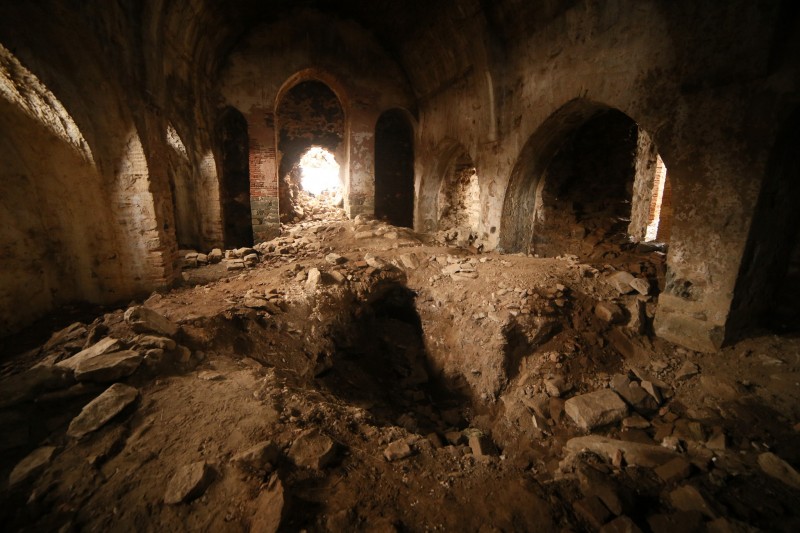
Inside St. Aghperig
We go next to Diyarbakir, from where we drive to the old village of Chunkush (now Cungus), to see the Dudan crevasse.
On the way we are stopped by the local military police, who want to see
the passports of all the attendees. Luckily the presence of so many
lawyers in our group encourages the police to let us go about our
business.
It was at Dudan (“waterfall” in Turkish) in 1915 that up to 10,000
local Armenians were thrown after having their throats cut by soldiers
on the order of the Ottoman governor Reşid Bey.
Locals have long told stories of the massacre, and we are joined by
local politicians and the descendants of Armenians who threw flowers
into the hole to remember the victims. It is an eerie place that
represents an open wound for the local population.
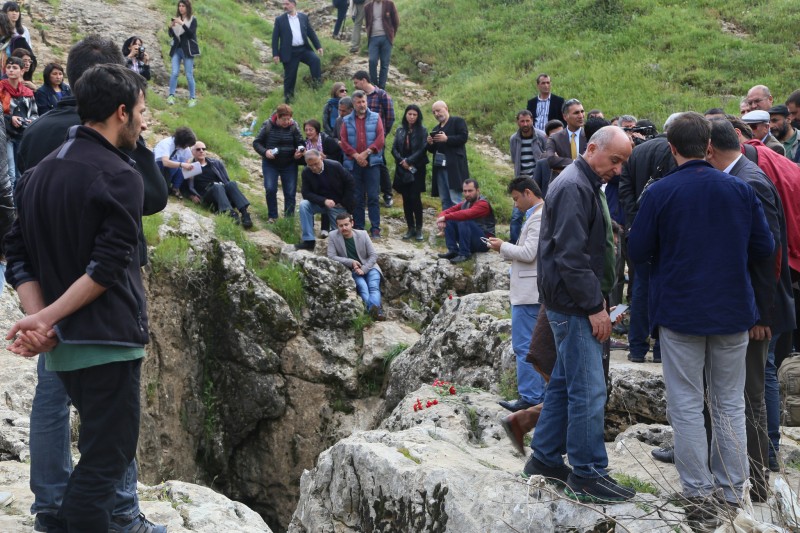
Dudan Cravasse
Half an hour outside of Batman there is a valley
carved into the landscape dotted by oil wells. Around 700 members of
the local Armenian elite were floated there on rafts on the Tigris river
in 1915. Ottoman soldiers handed them over to Kurdish executioners
recruited by the provincial governor. Remote sites like this valley were
chosen to hide the massacres from view, but those who witnessed the
killings passed on their stories to the next generations. A telegram
from one of the Ottoman leaders, Talaat Pasha, to a governor in Syria
warned him to hide the killings from public view, because “it is
important that, to save appearances, a show of gentle dealing shall be
made for a time and the usual measures be taken only in suitable
places.”
Not all Kurdish tribes participated in the genocide. Mihemede Miste
was a leader of the Reshkota Kurds in 1915 and opposed the orders of the
Ottoman governor of Diyarbakir to massacre Armenians. Miste’s house was
burned to the ground and he was forced into exile. His descendants were
touched to have our group visit
their village to honour their ancestor’s courage. Standing by Miste’s
graveside in the small village, Sarafian told his family that it was his
“duty, as a historian of the genocide, to bear witness to the reality
that many Muslims refused to kill their brothers and sisters. We should
celebrate people like Mihemede Miste as a bridge between the past and
the present and think of all the goodness that is in people”.

Mihemede Miste’s grave
On the eve of the anniversary we went to the newly renovated Sourp Giragos.
Giragos is a success story showing how places of cultural value to
Armenians can be successfully protected and restored in Turkey, despite
the lack of relations between the two countries. Hundreds of Kurds and
people with Armenian ancestry turned out to see a concert in the area,
but no mention was made of the centennial of the Genocide.
Sarafian proceeded to ring the church bells, as other Armenian church
bells were ringing at that time throughout the world to mark the canonisation
of the Armenian victims of 1915. However, local Armenians made him
stop, as the Istanbul Armenian patriarch had forbidden churches in
Turkey from participating in this world-wide event.
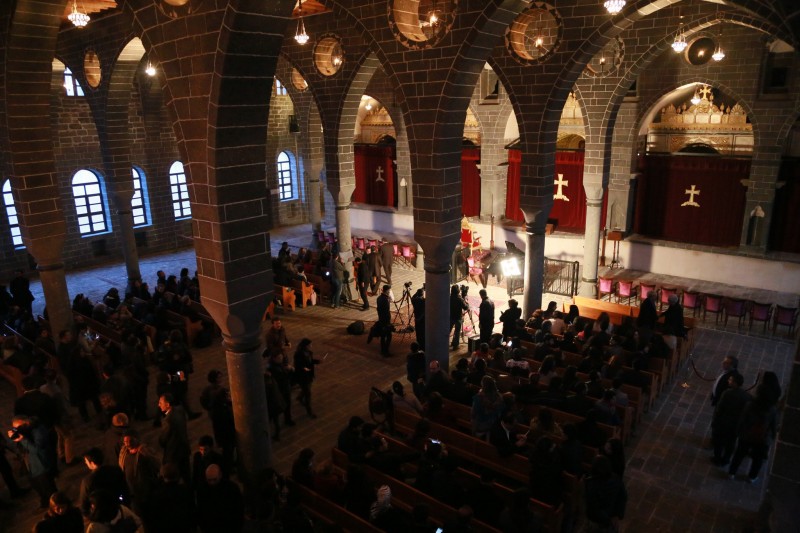
Sourp Giragos
On the morning of the April 24, our group went to the Syriac Orthodox
church of St Mary for a commemorative service where sermons were
delivered to remember those who died. Sarafian was not bound by any
rules here, and the bells were rung 100 times in memory of the dead.
A rally was organised by local lawyers, politicians and the
London-based Gomidas Institute. Selahattin Demirtaş, one of the leaders
of the opposition HDP party, gave a speech
in which he told the crowd that they had nothing to fear from Genocide
recognition, citing the example of Germany, which nobody today holds
responsible for the Holocaust perpetrated by the Nazis. His presence
drew hundreds of people to the dilapidated Sourp Sarkis Armenian church,
and showed how connected these events are to the upcoming general election in June.
HDP are the pro-Kurdish leftist party who made a strategic decision
following the Gezi protests to become the main progressive party in
Turkish politics, drawing people from across Turkey who dislike the
ruling AKP party but have little time for the old-fashioned nationalism
of the secular-Nationalist CHP party. Co-leader Selahattin Demirtaş has repeatedly recognised the genocide of 1915 and wants Turkey’s government to do the same.
“This is the result of many years of work”, Sarafian told another
journalist inside Sourp Sarkis. “This is just a dot along a path that we
would like to go towards reconciliation, allowing Kurds to come to
terms with the reality of the genocide, which they are. Ankara can say
whatever it wants, but we are going to the massacre sites, based not
just on archival knowledge but local knowledge. It is important that we
are here to engage in this way and create a language of reconciliation.
If you don’t talk, you keep accusing people; ‘we want territory, we want
this or that’, if that’s your attitude, that doesn’t allow for
reconciliation.”
Beyond the sombre mourning of the occasion, there was much hope
evident in Kurds, Armenians and Turks who want to set aside the
animosity of the past and build a country that can accept its history
and begin anew. It must be hoped that the defensiveness of nationalist
Turks can be overcome in order to build the bridges and understanding
necessary for recognition and reconciliation to take place.
Witnessing these commemorations which have been largely ignored by
Turkish and international media, it is clear that things are changing
fast within Turkish society. The dialogue must be allowed to continue.
(*) Photos by the author
(*) Photos by the author
"Global Voices" (globalvoicesonline.org), April 30, 2015
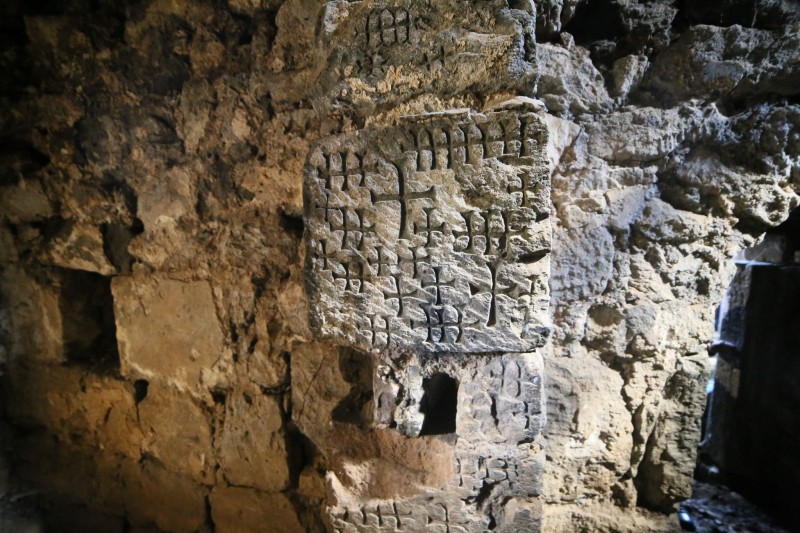
No comments:
Post a Comment